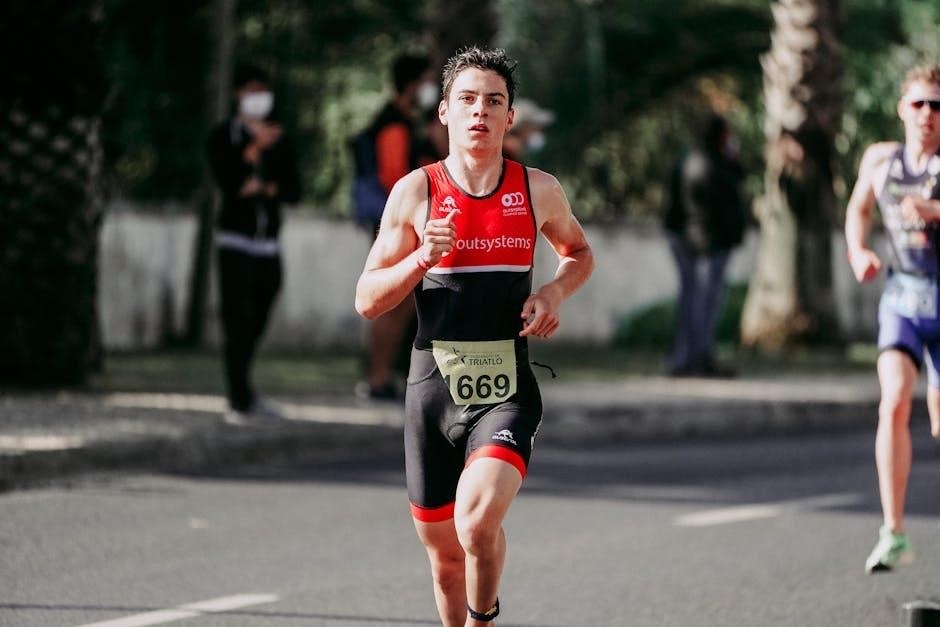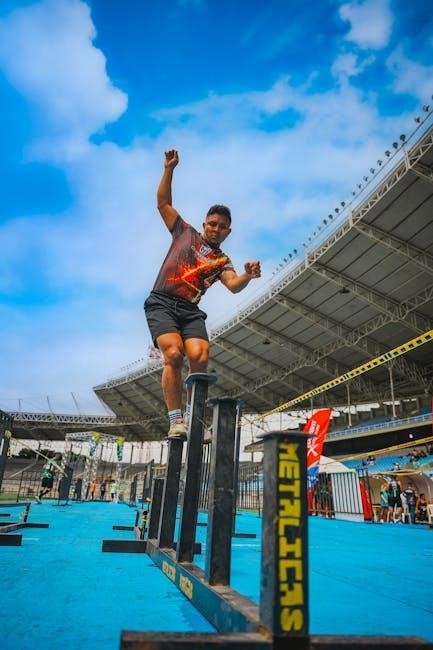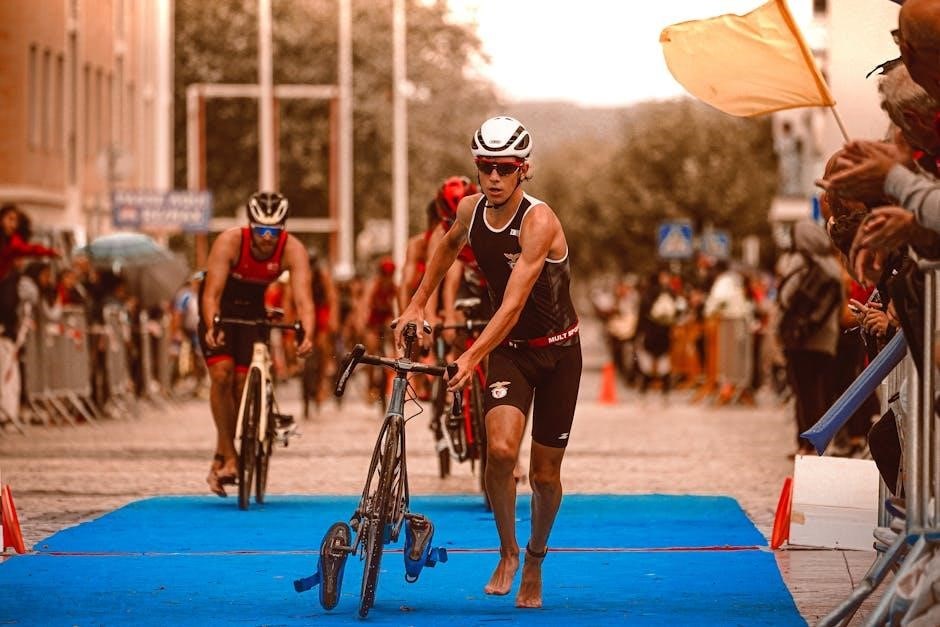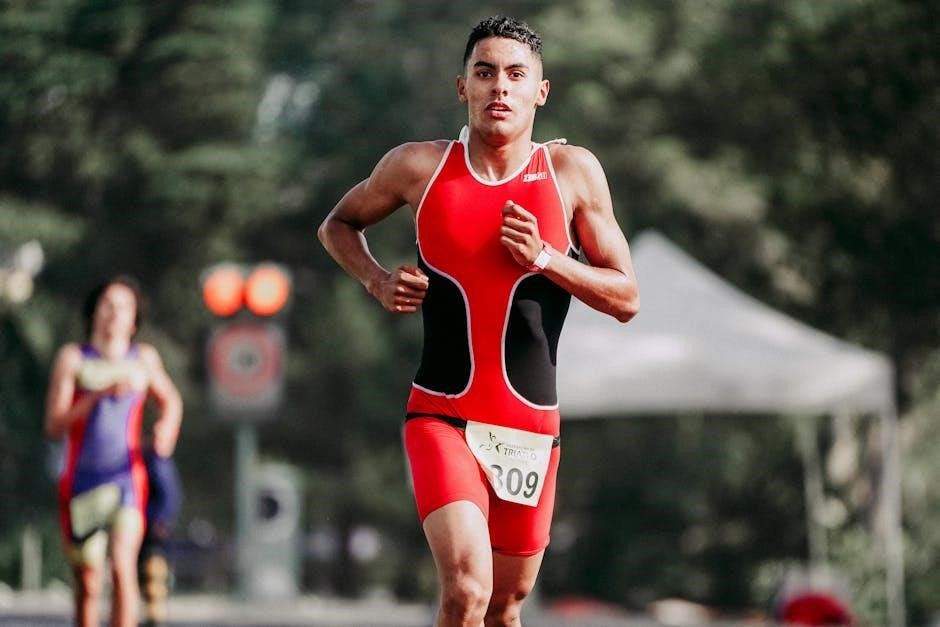Triathlon strength training is a cornerstone for enhancing endurance, power, and overall performance. It focuses on building muscular endurance and stability to support swimming, cycling, and running;
1.1 Importance of Strength Training for Triathletes
Strength training is essential for triathletes as it enhances endurance, power, and overall performance. It prevents injuries by strengthening muscles and joints, improves swimming, cycling, and running efficiency, and boosts speed. A well-structured program increases muscular endurance, stability, and coordination, reducing fatigue during long races. Strength training also supports the structural integrity needed for repetitive movements in triathlon disciplines, optimizing race performance and recovery.
1.2 Benefits of a Structured Strength Program
A structured strength program offers numerous benefits for triathletes, including improved power, speed, and endurance. It enhances muscular stability and coordination, reducing injury risk. The program boosts swimming, cycling, and running efficiency by targeting specific muscle groups, optimizing performance across all race distances. Additionally, it provides a solid foundation for endurance training, ensuring consistency and progress. A well-planned program also enhances recovery, allowing athletes to train more effectively and maintain peak performance throughout the season.

Phases of Strength Training for Triathletes
Triathlon strength training is divided into phases: anatomical adaptation, maximum strength, and transition/maintenance. Each phase builds on the previous, enhancing performance and reducing injury risk.
2.1 Anatomical Adaptation Phase
The anatomical adaptation phase focuses on building a foundation of strength and mobility. It prepares the body for more intense training by improving joint stability and muscle activation. This phase emphasizes low-intensity exercises to enhance flexibility and coordination, ensuring triathletes can handle the demands of subsequent training phases without injury. The goal is to create a strong, stable base that supports swimming, cycling, and running efficiently. This initial phase is crucial for long-term progress and injury prevention in a triathlon strength training program.
2.2 Maximum Strength Phase
The maximum strength phase focuses on building peak strength to enhance power and speed. It involves higher intensity exercises like deadlifts, squats, and pull-ups, targeting major muscle groups. This phase aims to improve neuromuscular efficiency and muscular endurance, translating to stronger swimming, cycling, and running. Triathletes typically spend 4-6 weeks in this phase, with increased load and lower repetitions to maximize strength gains. Proper form and recovery are emphasized to avoid injury and optimize performance improvements. This phase is critical for developing the raw strength needed for race-specific demands.
2;3 Transition and Maintenance Phases
The transition phase bridges strength gains to sport-specific training, reducing strength sessions while increasing endurance work. Maintenance phase sustains strength levels with minimal sessions, preventing detraining. Both phases ensure athletes retain strength benefits, supporting performance during race preparation. Focus shifts to functional movements and injury prevention, integrating strength with endurance training seamlessly. This balanced approach helps triathletes stay strong and resilient as they taper and peak for events. The goal is to maintain structural integrity and power, crucial for optimal race performance. Recovery and consistency are key during these phases to avoid overtraining and ensure readiness.
Key Components of a Triathlon Strength Program
A effective triathlon strength program includes mobility, flexibility, activation, and core exercises. It also focuses on building power and endurance to enhance overall performance and durability. Consistency is key.
3.1 Mobility and Flexibility Exercises
Mobility and flexibility are foundational for triathletes, enhancing range of motion and reducing injury risk. Exercises like stork stands and leg curls improve joint mobility, while dynamic stretches and yoga support muscle flexibility. These practices ensure efficient movement during swimming, cycling, and running, promoting better technique and endurance. Incorporating these exercises into a strength program helps maintain optimal physical function and prevents tightness that can hinder performance. Consistency is key to long-term flexibility and mobility gains, making them essential components of a triathlon strength program.
3.2 Activation and Core Strength
Activation exercises awaken key muscle groups, improving movement efficiency and reducing injury risk. Core strength is vital for triathletes, providing stability and power transfer between disciplines. Exercises like planks, bird dogs, and Russian twists target the abdominals and lower back, enhancing endurance and posture during long races. A strong core improves swimming strokes, cycling efficiency, and running stability, making it a cornerstone of any triathlon strength program. Consistent core work ensures better overall performance and resilience against fatigue. These exercises are essential for maintaining proper form and generating power across all three triathlon disciplines.
3.3 Power and Endurance Training
Power and endurance training bridges the gap between strength and sport-specific performance. Plyometric exercises, like box jumps, enhance explosive power, while resistance bands and interval training improve muscular endurance. High-repetition exercises, such as step-ups and lunges, boost stamina; Endurance-focused routines, including sustained core holds and tempo runs, simulate race conditions. This dual approach ensures triathletes can maintain intensity over long distances, delivering power when needed most. Balancing power and endurance training is crucial for optimizing performance in swimming, cycling, and running, making it a key component of any triathlon strength program.

A 12-Week Triathlon Strength Training Plan

A structured 12-week program designed to progressively build strength and endurance. It includes foundation building, strength development, and race-specific phases, ensuring a balanced approach to triathlon preparation;
4.1 Foundation Building (Weeks 1-4)
The first four weeks focus on establishing a solid foundation of strength and endurance. This phase introduces triathletes to essential exercises like squats, lunges, and core work, with a focus on proper form and technique. Sessions are designed to improve mobility, activation, and overall stability, ensuring a strong base for more intense training. Typically, this phase includes 2-3 strength sessions per week, with moderate intensity, 3-4 sets of 8-12 repetitions, and adequate recovery time to allow adaptation. Consistency and progressive overload are key to building resilience for the upcoming phases.
4.2 Strength Development (Weeks 5-8)
Weeks 5-8 focus on progressing strength through increased intensity and load. Triathletes transition to more dynamic movements, such as deadlifts, bench presses, and plyometrics, to build power and endurance. This phase emphasizes lower body strength, core stability, and functional exercises that directly translate to triathlon-specific movements. Sessions may include 4-5 sets of 6-10 repetitions with higher intensity, ensuring proper form and recovery. The goal is to enhance muscular endurance and power, preparing the body for the demands of race-specific training in the next phase while maintaining a balance between strength and technique.
4.3 Race-Specific Strength (Weeks 9-12)
Weeks 9-12 focus on race-specific strength, tailoring exercises to mimic triathlon demands. Emphasis is placed on functional movements like plyometrics, single-leg exercises, and core stability to enhance power and endurance. Triathletes incorporate sport-specific strength drills, such as swim strokes, bike positions, and running strides, to improve efficiency. Training intensity peaks with lower repetitions and higher loads, ensuring maximum strength transfer to race performance. This phase also integrates strength with endurance training, ensuring proper recovery and technique maintenance to prepare for the final push toward race day.

Exercise Selection for Triathletes
Effective exercise selection focuses on movements enhancing triathlon performance, such as pull-ups, squats, lunges, and core work, to build strength and endurance for swimming, cycling, and running.
5.1 Lower Body Strength Exercises
Lower body strength exercises are crucial for triathletes to enhance running, cycling, and swimming efficiency. Squats, lunges, deadlifts, and step-ups target key muscle groups like quads, hamstrings, and glutes. These movements improve power, stability, and endurance, reducing injury risk. Proper form and progressive overload ensure continuous gains. Incorporating these exercises into a structured program helps triathletes maintain strength throughout the race season and supports overall performance across all disciplines.
5.2 Upper Body and Core Exercises
Upper body and core exercises are essential for triathletes to improve posture, reduce injury risk, and enhance swimming, cycling, and running efficiency. Pull-ups, push-ups, and rows strengthen the shoulders and back, benefiting swimming. Planks, Russian twists, and leg raises target core muscles, improving stability and endurance. Shoulder presses and tricep dips enhance cycling and running posture. A strong upper body and core provide the structural foundation needed for consistent performance across all three disciplines, ensuring triathletes can maintain form and power throughout races.
5.3 Functional Movements for Triathlon-Specific Needs
Functional movements are tailored to mimic triathlon-specific actions, enhancing performance in swimming, cycling, and running. Deadlifts and step-ups improve running power and stability, while pull-ups and rows strengthen swimming efficiency. Dynamic exercises like rotational movements and single-leg balances simulate cycling and running motions, improving coordination. These exercises target muscle groups used in triathlon, ensuring movements are efficient and injury-resistant. Incorporating functional movements into a strength program bridges the gap between gym work and race-day performance, making them indispensable for triathletes seeking to optimize their training.

Nutrition and Recovery for Strength Training
A balanced diet rich in protein, carbs, and fats fuels strength training. Adequate hydration and recovery techniques like stretching, foam rolling, and sleep optimize muscle repair and growth.
6.1 Balanced Nutrition for Optimal Performance
A well-structured nutrition plan is vital for triathletes to maximize strength training benefits. A balanced diet should include lean proteins to repair muscles, complex carbohydrates for energy, and healthy fats for hormonal balance. Proper hydration is also essential to maintain performance and recovery. Timing meals around workouts can enhance energy levels and recovery efficiency. Additionally, avoiding excessive sugar and processed foods helps maintain consistent energy and supports overall health and performance. Monitoring calorie intake ensures that athletes meet their energy needs without compromising training quality or recovery. A tailored nutrition plan can significantly boost endurance and strength gains, enabling triathletes to perform at their best.
6.2 Recovery Techniques to Enhance Strength Gains
Effective recovery is crucial for maximizing strength gains in triathlon training. Techniques such as stretching, foam rolling, and massage help reduce muscle soreness and improve flexibility. Adequate sleep is essential for muscle repair and adaptation, with 7-9 hours recommended nightly. Post-workout nutrition, including protein and carbohydrates, aids in muscle recovery. Active recovery, like light swimming or cycling, promotes blood flow without overtaxing the body. Additionally, compression garments and ice baths can reduce inflammation and enhance recovery efficiency. Incorporating these methods ensures athletes can train consistently and achieve optimal strength gains.

Avoiding Common Mistakes in Strength Training
Common mistakes include neglecting recovery, poor form, overtraining, and inadequate progression. Consistency and proper technique are key to avoiding injuries and ensuring effective strength gains.
7.1 Overtraining and Injury Prevention
Overtraining is a common pitfall in triathlon strength training, leading to injuries and decreased performance. It occurs when athletes exceed their training thresholds without adequate recovery. To prevent this, incorporate rest days, ensure proper nutrition, and maintain consistent sleep schedules. Listen to your body and adjust intensity based on recovery status. Poor form and ignoring muscle imbalances can also lead to injuries. Focus on progressive overload and avoid excessive volume. Prioritize mobility exercises and incorporate injury-specific prevention strategies to maintain long-term consistency and health in your training program.
7.2 Proper Form and Technique
Proper form and technique are vital in triathlon strength training to maximize effectiveness and prevent injuries. Consistent focus on movement quality ensures targeted muscle engagement and reduces strain on joints. Incorporate mobility exercises to improve range of motion and maintain proper posture during lifts. Core strength is essential for stability, enabling efficient power transfer across all disciplines. Use instructional videos or work with a coach to refine form. Prioritizing technique fosters long-term progress and injury resilience, allowing triathletes to train safely and effectively throughout their program.
7.4 Integrating Strength with Endurance Training
Integrating strength training with endurance workouts is crucial for triathletes to optimize performance. Strength sessions should complement, not conflict with, swim, bike, and run training. Plan strength workouts during low-intensity endurance phases to build a foundation, then taper strength as race-specific training intensifies. Use periodized training to balance both aspects, ensuring adequate recovery. This integration enhances muscular endurance, power, and overall race performance without overtraining; A well-structured plan ensures triathletes can maintain consistency in both strength and endurance, leading to peak race readiness. Proper scheduling is key to achieving this balance effectively.
A well-structured strength program enhances triathlon performance. Consistency and proper integration with endurance training are key. Use the plan to achieve peak race readiness and continued progress.
8.1 Tracking Progress and Adjusting the Plan
Monitoring progress in a triathlon strength program involves tracking workout performance, heart rate zones, and recovery. Adjustments should be based on how your body responds, ensuring continuous improvement. Incorporate periodization to avoid plateaus and maintain motivation. Regularly assess strength gains, endurance levels, and technique to fine-tune the program. Use tools like training logs or apps to document progress and make data-driven decisions. Adjust intensity, volume, or exercises as needed to stay on track and optimize results for race day. Consistent evaluation ensures the program remains effective and aligned with your goals.
8.2 Transitioning to Race-Specific Training
Transitioning to race-specific training involves tapering strength sessions and focusing on sport-specific drills. As race day approaches, reduce the intensity of strength workouts to avoid injury and allow your body to adapt. Incorporate swim, bike, and run drills to enhance technique and endurance. Ensure proper periodization by balancing strength and endurance training. This phased approach ensures peak performance during competition. Gradually increase race-pace simulations to build confidence and mental readiness. Proper timing of this transition is key to maintaining strength gains while optimizing endurance capabilities for the event.
8.3 Long-Term Strength and Performance Goals
Long-term strength and performance goals focus on sustained progress and injury prevention. Aim to build a robust foundation through periodized training, ensuring consistent improvement. Set clear, measurable objectives for strength and endurance. Gradually increase intensity and complexity of workouts to avoid plateaus. Prioritize proper recovery and technique refinement. Maintaining a balanced approach between strength and endurance training ensures long-term success. Periodically reassess goals to align with evolving race demands and personal growth. This structured, patient approach fosters resilience and peak performance over time, helping triathletes achieve their full potential and maintain a high level of competitiveness.